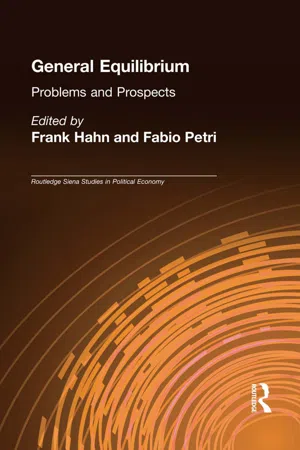
- 544 pages
- English
- ePUB (mobile friendly)
- Available on iOS & Android
About This Book
In recent years certain leading figures in the world of economics have called the usefulness of general equilibrium theory into question. This superb new book brings together leading economic theorists with important contributions to the ongoing debate.
General equilibrium theorists including Michio Morishima, Michael Magill and Martine Quinzii debate strengths, weaknesses and possible futures with leading thinkers such as Herb Gintis, Pierangelo Garegnani and Duncan Foley, who seek to explain the rejection of general equilibrium. Uniquely, none of the contributors portray general equilibrium theory as the perfect guide to market economies actual behaviour, but rather illustrate that there is insufficient acquaintance with existing alternatives and that general equilibrium theory is often used as an ideal 'benchmark'.
Frequently asked questions
Information
1
Existence of GE
Are the cases of non-existence a cause for serious worry?*
1.1 INTRODUCTION
Table of contents
- Cover
- Half Title
- Series Page
- Title Page
- Copyright Page
- Contents
- List of contributors
- Acknowledgements
- Introduction
- Introduction
- 1 Existence of GE: are the cases of non-existence a cause for serious worry?
- 2 Learning in intertemporal equilibrium models and the sunspot case
- 3 Disequilibrium and stability
- 4 Statistical equilibrium in economics: method, interpretation, and an example
- 5 Savings, investment and capital in a system of general intertemporal equilibrium
- 6 Some implications of endogenous contract enforcement for general equilibrium theory
- 7 Macroeconomics and general equilibrium
- 8 ‘Classical’ vs. ‘neoclassical’ theories of value and distribution and the long-period method
- 9 Endogenous uncertainty and rational belief equilibrium: a unified theory of market volatility
- 10 Incentives and the stock market in general equilibrium
- 11 Intermediation, the stock market and intergenerational transfers
- 12 The sequential indeterminacy problem
- 13 General equilibrium and the destiny of capitalism à la Schumpeter
- 14 A ‘Sraffian’ critique of general equilibrium theory, and the classical-Keynesian alternative
- 15 Competitive equilibrium and non-cooperative game theory: noise and bounded rationality
- 16 Applications of the classical approach
- 17 General equilibrium: problems, prospects and alternatives – an attempt at synthesis
- 18 General equilibrium: problems, prospects and alternatives – final discussion
- Index